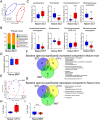Reactive granulopoiesis depends on T-cell production of IL-17A and neutropenia-associated alteration of gut microbiota
- PMID: 36409919
- PMCID: PMC9860329
- DOI: 10.1073/pnas.2211230119
Reactive granulopoiesis depends on T-cell production of IL-17A and neutropenia-associated alteration of gut microbiota
Abstract
Granulopoiesis in the bone marrow adjusts cellular output as demand for neutrophils changes. Reactive granulopoiesis is induced by profound neutropenia, but its mechanism remains to be clarified. We herein explored its mechanisms using mouse models of syngeneic hematopoietic stem cell transplantation (SCT) and 5-fluorouracil-induced neutropenia. After SCT, T cell production of IL-17A was up-regulated. Neutrophil recovery was significantly delayed in IL-17A-deficient or T cell-deficient RAG1-/- mice, and adoptive transfer of wild-type (WT) T cells facilitated neutrophil engraftment. Gut decontamination with oral antibiotics suppressed T cell production of IL-17A and impaired neutrophil recovery. Transplantation of fecal microbiota collected from neutropenic, not naive, mice promoted neutrophil recovery in these mice, suggesting that neutropenia-associated microbiota had a potential to stimulate reactive granulopoiesis. Our study uncovered a cross talk between gut microbiota and neutropenia after SCT and chemotherapy.
Keywords: Ruminococcaceae; granulopoiesis; hematopoietic stem cell transplantation; microbiota; neutropenia.
Conflict of interest statement
The authors declare no competing interest.
Figures






Similar articles
-
T-lineage cells require the thymus but not VDJ recombination to produce IL-17A and regulate granulopoiesis in vivo.J Immunol. 2009 Nov 1;183(9):5685-93. doi: 10.4049/jimmunol.0900887. J Immunol. 2009. PMID: 19843951 Free PMC article.
-
Mycophenolic acid suppresses granulopoiesis by inhibition of interleukin-17 production.Kidney Int. 2010 Jul;78(1):79-88. doi: 10.1038/ki.2010.84. Epub 2010 Apr 7. Kidney Int. 2010. PMID: 20375992
-
IL-23 is required for neutrophil homeostasis in normal and neutrophilic mice.J Immunol. 2007 Dec 15;179(12):8274-9. doi: 10.4049/jimmunol.179.12.8274. J Immunol. 2007. PMID: 18056371
-
Phagocytosis of apoptotic neutrophils regulates granulopoiesis via IL-23 and IL-17.Immunity. 2005 Mar;22(3):285-94. doi: 10.1016/j.immuni.2005.01.011. Immunity. 2005. PMID: 15780986
-
Gut Microbiota and IL-17A: Physiological and Pathological Responses.Probiotics Antimicrob Proteins. 2019 Mar;11(1):1-10. doi: 10.1007/s12602-017-9329-z. Probiotics Antimicrob Proteins. 2019. PMID: 28921400 Review.
Cited by
-
Modulation of Bifidobacterium by HD5 during weaning is associated with high abundance in later life.Commun Med (Lond). 2025 Jul 1;5(1):250. doi: 10.1038/s43856-025-00977-6. Commun Med (Lond). 2025. PMID: 40595013 Free PMC article.
-
Changes in gut microbiota predict neutropenia after induction treatment in childhood acute lymphoblastic leukemia.Blood Adv. 2025 Apr 8;9(7):1508-1521. doi: 10.1182/bloodadvances.2024013986. Blood Adv. 2025. PMID: 39561377 Free PMC article.
-
Proteomic analysis reveals dysregulation of peripheral blood neutrophils in patients with Multiple Sclerosis.Clin Exp Immunol. 2025 Jan 21;219(1):uxae115. doi: 10.1093/cei/uxae115. Clin Exp Immunol. 2025. PMID: 39817476 Free PMC article.
-
Role of gut microbiota in predicting chemotherapy-induced neutropenia duration in leukemia patients.Front Microbiol. 2025 Mar 19;16:1507336. doi: 10.3389/fmicb.2025.1507336. eCollection 2025. Front Microbiol. 2025. PMID: 40177485 Free PMC article.
References
Publication types
MeSH terms
Substances
LinkOut - more resources
Full Text Sources
Molecular Biology Databases

